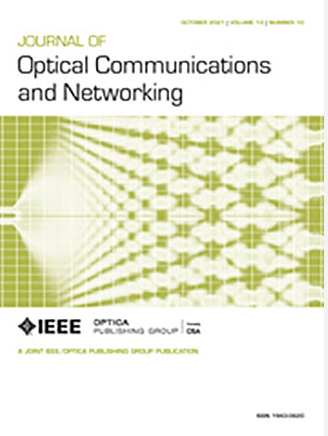使用molennetwork为技术经济研究生成现实的光学拓扑
IF 4.3
2区 计算机科学
Q1 COMPUTER SCIENCE, HARDWARE & ARCHITECTURE
引用次数: 0
摘要
几十年来,模型网络及其底层拓扑一直被用作技术经济研究的参考。现有的光网络参考拓扑可能涵盖不同的网段,如骨干网、城域核心网、城域聚合网、接入网和/或数据中心网。当电信运营商致力于优化其现有部署的光网络时,不同拓扑的可用性对于研究人员和技术开发人员在各种场景中测试其解决方案并验证能效或降低成本方面的性能非常有用。本文介绍了一个开源工具MoleNetwork,它可以生成图形(骨干网、城域核心网和城域聚合网),灵感来自电信运营商的真实网络拓扑,可以用作技术经济研究的基准。一个新的拓扑,据我们所知,Italy2k,是基于实际运营商网络的结构生成的。然后,通过验证在生成的拓扑中是否匹配预期的运营商参数,并使用拓扑来预测其城域(核心和聚合网络)的一个10年期间的技术需求,对该工具进行测试。本文章由计算机程序翻译,如有差异,请以英文原文为准。
Generating realistic optical topologies for techno-economic studies using MoleNetwork
Model networks and their underlying topologies have been used as a reference for techno-economic studies for several decades. Existing reference topologies for optical networks may cover different network segments such as backbone, metro core, metro aggregation, access, and/or data center. While telecommunication operators work on the optimization of their own existing deployed optical networks, the availability of different topologies is useful for researchers and technology developers to test their solutions in a variety of scenarios and validate the performance in terms of energy efficiency or cost reduction. This paper presents an open-source tool, MoleNetwork, to generate graphs (backbone, metro core, and metro aggregation) inspired by real network topologies of telecommunication operators that can be used as benchmarks for techno-economic studies. A new topology, to our knowledge, Italy2k, is generated based on the structure of a real operator’s network. Then, the tool is tested by validating that the expected operator parameters are matched in the generated topology and by using the topology to forecast technical demands in a 10-year period in one of its metro regions (core and aggregation networks).
求助全文
通过发布文献求助,成功后即可免费获取论文全文。
去求助
来源期刊
CiteScore
9.40
自引率
16.00%
发文量
104
审稿时长
4 months
期刊介绍:
The scope of the Journal includes advances in the state-of-the-art of optical networking science, technology, and engineering. Both theoretical contributions (including new techniques, concepts, analyses, and economic studies) and practical contributions (including optical networking experiments, prototypes, and new applications) are encouraged. Subareas of interest include the architecture and design of optical networks, optical network survivability and security, software-defined optical networking, elastic optical networks, data and control plane advances, network management related innovation, and optical access networks. Enabling technologies and their applications are suitable topics only if the results are shown to directly impact optical networking beyond simple point-to-point networks.

 求助内容:
求助内容: 应助结果提醒方式:
应助结果提醒方式:


